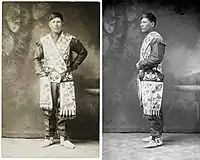Bandolier bag
A bandolier bag or gashkibidaagan is a beaded shoulder bag with a wide strap often ornately decorated with beadwork made by the Ojibwe women. Also known as Bandolier bags, similar bags are made and worn by several North American tribes. They are cultural icons among the Ojibwe, (also known as Anishinaabe, Chippewa, Ojibwa and other variants). Gashkibidaagan served as a valuable form of exchange and represented leadership and status within the community. The Ojibwe name comes from the word parts, gashk-, meaning "enclosed, attached together" and -bid, "tie it" The English word bandolier, defined as "broad belt, belt, or scarf worn over one shoulder and under the other" comes from the French word bandouliere meaning "shoulder belt" and traces back to the spanish bandoera, the diminutive of banda "sash." A bandolier was a broad belt that had loops to hold powder charges or cartridges European infantry soldiers wore them as early as the 16th century. A bandolier bag may be worn either across the shoulder to the side or in front like an apron.[1][2]

Bandolier bags are often incorrectly called medicine bags.
 A 1930 bandolier bag from Lake Superior Chippewa Indians, Lac Du Flambeau, Wisconsin, on at the Wabeno Logging Museum in Wabeno, Wisconsin, U.S.
A 1930 bandolier bag from Lake Superior Chippewa Indians, Lac Du Flambeau, Wisconsin, on at the Wabeno Logging Museum in Wabeno, Wisconsin, U.S. Ojibwa bandolier bag overall, c. 1900, in the collection of The Children's Museum of Indianapolis
Ojibwa bandolier bag overall, c. 1900, in the collection of The Children's Museum of Indianapolis Ojibwa bandolier bag detail, c. 1900, in the collection of The Children's Museum of Indianapolis
Ojibwa bandolier bag detail, c. 1900, in the collection of The Children's Museum of Indianapolis Medwewinind of the White Earth Band, 1894, is shown wearing a Bandolier bag.
Medwewinind of the White Earth Band, 1894, is shown wearing a Bandolier bag.
References
- Giese, Paula (1997). "Bandolier Exhibit Menu". Native American Indian: Art, Culture, Education, History, Science. Archived from the original on 2011-01-19. Retrieved 2017-04-20.
- Anderson, Marcia (2017). A Bag Worth a Pony: The Art of the Ojibwe Bandolier Bag. St. Paul, Minnesota: Minnesota Historical Society Press. pp. 11–12. ISBN 978-1-68134-029-6.